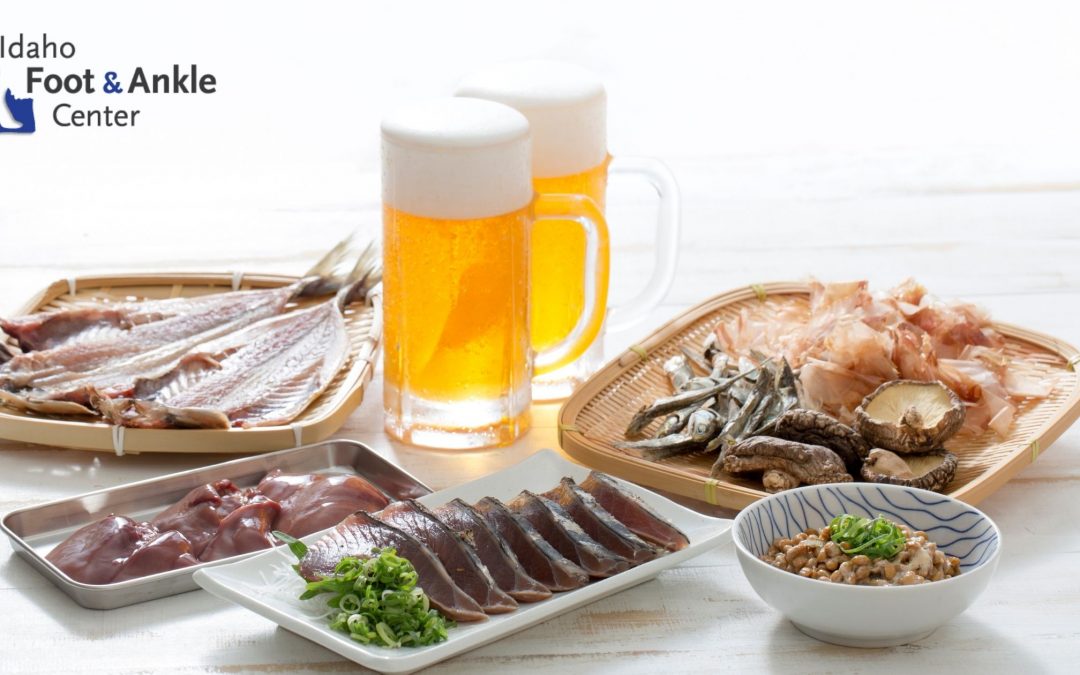The holiday season is here! This is a wonderful time for family, friends, and good food. Sometimes, the food we eat may taste good, but isn’t necessarily GOOD FOR US! Did you ever think that the pain in your foot may be caused by the food you ate? That can be the case with gout! Changes in diet, including overindulging in certain foods and beverages, can cause gout attacks this time of year.
WHAT IS GOUT?
Gout is a disorder that results from the buildup of uric acid in the tissues or a joint. Uric acid is the result of the breakdown of purines, chemicals found naturally in our bodies and in food. It is present in the blood, and then eliminated in the urine. Gout attacks are caused by deposits of crystallized uric acid in the joint.
Gout occurs most commonly in the big toe because uric acid is sensitive to temperature changes. At cooler temperatures, uric acid turns into crystals. Since the toe is the part of the body that is farthest from the heart, it is also the coolest part of the body and, thus, the most likely target of gout. However, gout can affect any joint in the body. While gout is more common in men aged 40 to 60 years, it can occur in men and women of all ages.
WHAT ARE THE SYMPTOMS OF GOUT?
An attack of gout can be miserable, marked by the following symptoms:
- Intense pain that comes on suddenly, often in the middle of the night or upon arising
- Signs of inflammation, such as redness, swelling, and warmth over the joint
WHAT CAUSES GOUT?
The tendency to accumulate uric acid is often inherited. Other factors that put a person at risk for developing gout include:
- High Blood Pressure
- Diabetes
- Obesity
- Surgery
- Chemotherapy
- Stress
- Certain medications and vitamins including aspirin, water pills, and niacin.
- Diet that includes high levels of purines
Foods that contain more purines than others have been associated with an increase of uric acid which leads to gout. Avoid or limit shellfish, organ meats, red wine, beer, and red meat to reduce your chances of getting a gout attack.
HOW IS GOUT TREATED?
Initial treatment of an attack of gout typically includes the following:
- Medications. Prescription medications or injections are used to treat the pain, swelling, and inflammation.
- Dietary restrictions. Foods and beverages that are high in purines should be avoided since purines are converted in the body to uric acid.
- Fluids. Drink plenty of water and other fluids each day, while also avoiding alcoholic beverages, which cause dehydration.
- Immobilize and elevate the foot. Avoid standing and walking to give your foot a rest. Also, elevate your foot (level with or slightly above the heart) to help reduce swelling.
Gout symptoms can usually be resolved in 3-10 days with treatment. If symptoms persist, a maintenance treatment with daily medication may be needed. It is important not to ignore the symptoms of gout, as the build-up of uric acid over time can cause arthritic damage to the joint.
If you are experiencing painful symptoms in your foot or ankle, please contact Dr. Kylin Kovac and Dr. Jed Erickson at Idaho Foot and Ankle Center. They specialize in disorders and injuries of the foot and ankle, and they can provide you with the right diagnosis and treatment plan the first time. Dr. Kovac and Dr. Erickson want to help get you back to the activities you love!
Some content provided by The ACFAS.



Recent Comments